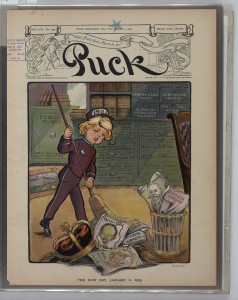This is a guest post by Johnathan Abreu of the Library of Congress.
What can a political cartoon say that a drawing or photograph can’t?
The political cartoon has a well-established tradition of providing visual commentary on public affairs and lampooning public figures. Political cartoons are generally believed to originate with Benjamin Franklin’s “Join or Die,” a commentary on the need for North American colonial unity published in the Pennsylvania Gazette in 1754.
The Library of Congress houses collections of political cartoons extending from the 18th century until well into the 20th century and touching on a number of themes and topics that you might explore with students. Here’s a guide to a few helpful posts on using political cartoons in the classroom from the Teaching with the Library of Congress blog.
Political Cartoons: Seriously Funny
This post by Stephen Wesson offers entry points for locating and teaching with political cartoons. You will also find links to additional resources to dive further into the Library’s collections of political cartoons.
A Clean Sweep for the New Year: Exploring a Cartoon from the Turn of the Twentieth Century
Another post by Educational Resource Specialist Cheryl Lederle provides a guide to analyzing a specific political cartoon published on the cover of the January 1905, edition of Puck magazine. You can also find a number of helpful teaching tips and approaches to analyzing a political cartoon with a group of students.
Theodore Roosevelt’s Thanksgiving Truce: A Political Cartoon
Educational Resource Specialist Stacie Moats focuses on a political cartoon published November 1905, featuring then-President Theodore Roosevelt. This entry walks you through an analysis of the cartoon, and identifies links to resources where students can learn more about Roosevelt and the historical context of the cartoon. As in other posts which highlight the Library’s primary sources, there are plenty of suggestions for using the cartoon with students.
Look out for more posts highlighting some of the best posts from the Teaching with the Library of Congress blog.
When working with political cartoons, don’t forget to consult the Teacher’s Guide Analyzing Political Cartoons for questions and activities to guide and deepen student thinking and analysis.



June 13, 2012 at 2:55 pm
the cartoons is the best element for learning and teaching about matter that the child havnot opportunity for experience because many experiences are very dangoures but cartoon making opportunity for students and children that increasing their conception and they will ability for relvant between subjective and objective
June 24, 2012 at 10:42 am
At a middle school I sub at often I use the weekly reader as a teaching aid, and there is a cartoon that the students have to explain I find that most don’t know the concept behind those cartoons. Most students find it difficult to interupt. The cartoons are a very good guage of the childs conceptual abilites.